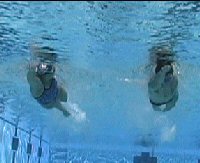12/23/04 Unequal Degree of Rotation
Text and Photo/Video by Glenn Mills
Demonstrated by Kaitlin Sandeno and Erik Vendt
Premium
Members - Click Here to Download Bonus Video Clip (Windows Media Player Format
1.2MB)
Premium
Members - Click Here to Download Bonus Video Clip (Quick Time Format 1.3MB)
Rotation is one of the most important elements in fast swimmer. Whether itís
rotation around the hips (short axis) or through the body (long axis), rotation
is a way to add power, decrease resistance, and connect your entire body to the
swimming process.
The question is not whether rotation is important, itís HOW MUCH rotation is
enoughÖand how much is TOO much?
Letís take a look at Kaitlin Sandeno and Erik Vendt, two of the best swimmers
in the world, who just happened to be swimming freestyle right next to each
other for an upcoming video. Youíll notice that both of these accomplished
distance freestylers incorporate tremendous rotation and extension in their
stroke. Itís clear that Kaitlin rotates MORE than Erik does. But does that make
Kaitlinís stroke BETTER than Erikís?
The answer is NO. What each of these extremely talented athletes his discovered
-- after much time, effort, and feedback from their great coaches Ė is the
degree of rotation that works for THEM.


|
These visual images can do more to educate you
as a swimmer than any words I can write. Watch the video over and over, and
then go swim. Experiment with varying degrees of rotation. Observe how rotation
affects your stroke rate. See how rotation affects your ability to extend
completely out front. Notice how rotation enables you to pull harder against
the water, because your arms are tied into the movement of the body.
|
Get feedback from your coach, because he or she can see the flow and rhythm of
your stroke from on deck. A coach can let you know if youíre rotating too
muchÖor too little.
While rotation is extremely important, itís up to YOU (and your coach) to
determine the degree of rotation thatís best for YOU. THATíS the most important
aspect of rotation.